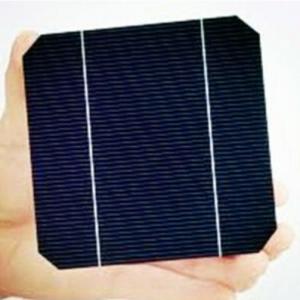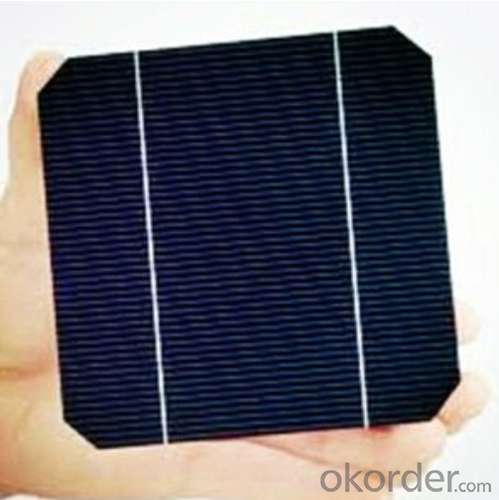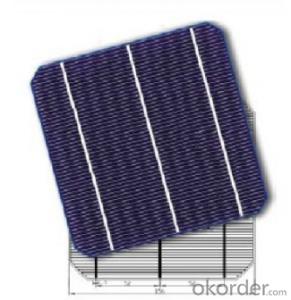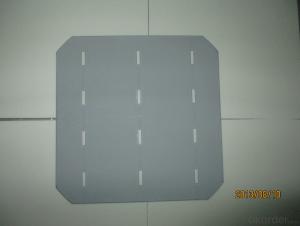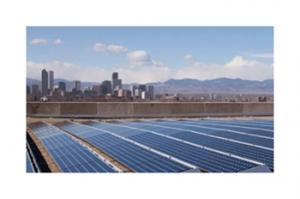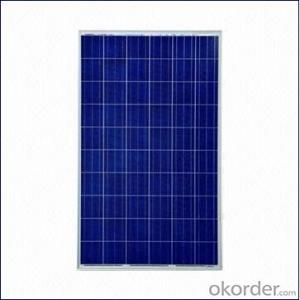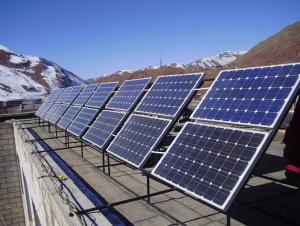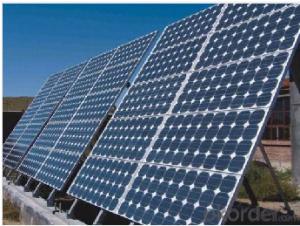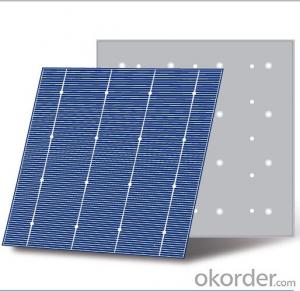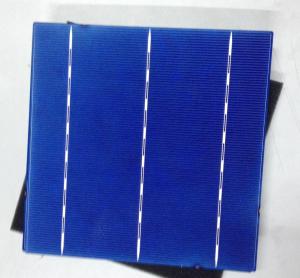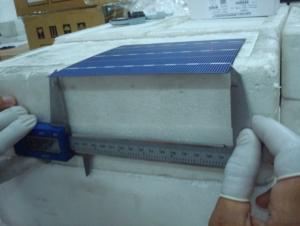Fraunhofer Solar Cells for Solar Panel Mono/Polycrystalline 156
- Loading Port:
- China main port
- Payment Terms:
- TT or LC
- Min Order Qty:
- 100000 watt
- Supply Capability:
- 10000000 watt/month
OKorder Service Pledge
OKorder Financial Service
You Might Also Like
1. Structure of Solar Cell for Solar Panel Monocrystalline and Polycrystalline 156
A solar cell, or photovoltaic cell, is an electrical device that converts the energy of light directly into electricity by the photovoltaic effect, which
is a physical and chemical phenomenon.
It is a form of photoelectric cell, defined as a device whose electrical characteristics, such as current, voltage, or resistance, vary when exposed to light.
Solar cells are the building blocks of photovoltaic modules, otherwise known as solar panels.

2. Main Features of the Solar Cell for Solar Panel Monocrystalline and Polycrystalline 156
• 16.8%~18.25% high efficiency
• 100% checked quality
• SO9001/ISO14001/TUV/UL
• fast lead time
3. Solar Cell for Solar Panel Monocrystalline and Polycrystalline 156 Images
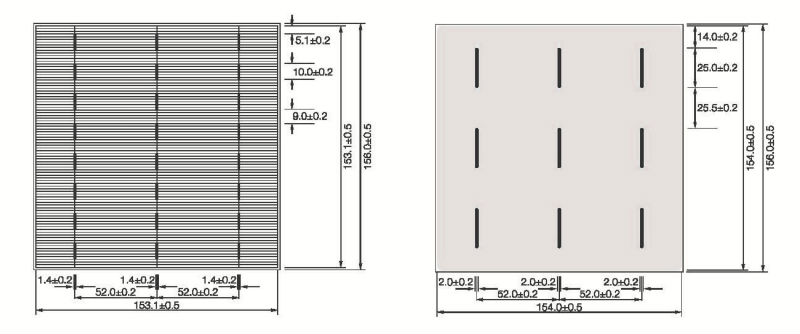
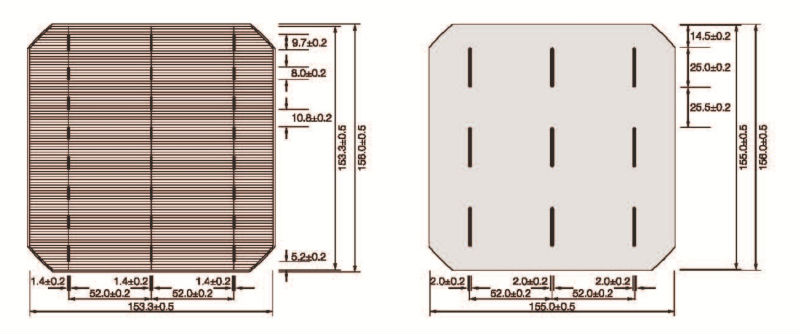
4. Solar Cell for Solar Panel Monocrystalline and Polycrystalline 156 Specification
poly 156 cell Electrical Characteristics( solar cell for solar panel ) | ||||||||||||
Efficiency(%) | 18 | 17.8 | 17.6 | 17.4 | 17.2 | 16.8 | 16.6 | 16.4 | 16.2 | 16 | 15.8 | 15.6 |
Pmpp(W) | 4.33 | 4.29 | 4.24 | 4.19 | 4.14 | 4.09 | 4.04 | 3.99 | 3.94 | 3.9 | 3.86 | 3.82 |
Umpp(V) | 0.53 | 0.527 | 0.524 | 0.521 | 0.518 | 0.516 | 0.514 | 0.511 | 0.509 | 0.506 | 0.503 | 0.501 |
Impp(A) | 8.159 | 8.126 | 8.081 | 8.035 | 7.99 | 7.938 | 7.876 | 7.813 | 7.754 | 7.698 | 7.642 | 7.586 |
Uoc(V) | 0.633 | 0.631 | 0.628 | 0.625 | 0.623 | 0.62 | 0.618 | 0.617 | 0.615 | 0.613 | 0.611 | 0.609 |
Isc(A) | 8.709 | 8.677 | 8.629 | 8.578 | 8.531 | 8.478 | 8.419 | 8.356 | 8.289 | 8.22 | 8.151 | 8.083 |
mono 156 Electrical Characteristics( solar cell for solar panel ) | ||||||||||||
Efficiency(%) | 20 | 19.2 | 19 | 18.8 | 18.6 | 18.4 | 18.2 | 18 | 17.8 | 17.6 | 17.4 | 17.2 |
Pmpp(W) | 4.59 | 4.54 | 4.49 | 4.45 | 4.4 | 4.35 | 4.3 | 4.26 | 4.21 | 4.16 | 4.11 | 4.08 |
Umpp(V) | 0.541 | 0.54 | 0.538 | 0.535 | 0.533 | 0.53 | 0.527 | 0.523 | 0.519 | 0.518 | 0.516 | 0.514 |
Impp(A) | 8.484 | 8.407 | 8.346 | 8.318 | 8.255 | 8.208 | 8.159 | 8.145 | 8.112 | 8.031 | 7.95 | 7.869 |
Uoc(V) | 0.64 | 0.639 | 0.638 | 0.637 | 0.636 | 0.634 | 0.632 | 0.631 | 0.63 | 0.629 | 0.628 | 0.627 |
Isc(A) | 8.972 | 8.959 | 8.936 | 8.912 | 8.875 | 8.83 | 8.805 | 8.787 | 8.775 | 8.695 | 8.615 | 8.535 |
5. FAQ of Solar Cell for Solar Panel Monocrystalline and Polycrystalline 156
Q1. How long can we receive the product after purchase?
A1.In the purchase of product within three working days, We will arrange the factory delivery as soon as possible. The pecific time of
receiving is related to the state and position of customers
Q2. Can we visit your factory?
A2:Surely, I will arrange the trip basing on your business schedule.
Most Common Uses of Solar Cells
Perhaps the most popular use of solar energy is one that doesn't involve technology at all: drying wet things. People around the world depend upon the sun to dry everything from laundry to crops. It's an effective way to achieve a goal without relying upon electricity.
It may seem unusual, but solar power has become a popular way to provide power to lighting systems that activate after the sun goes down. From street lights to garden lamps, solar power provides the energy needed to illuminate the darkness late into the night. These lights contain batteries that charge during the day as sunlight hits the solar cells. At night, a photoresistor detects the absence of light and a circuit board triggers the batteries to discharge and provide power to LED lights, which are efficient and bright.
Solar cells are very useful in powering space vehicles such as satellites and telescopes (e.g. Hubble). They provide a very economical and reliable way of powering objects which would otherwise need expensive and cumbersome fuel sources.
The above design for a solar cell array in space features many inflatable, fresnel reflectors which focus the Sun's light on small arrays of high efficiency cells.
The international space station is also another good example of solar cells being used in space. When it is finished, the station will have the most powerful solar array in space. Four sets of gold coloured wings (each one being 72 metres long and larger than the space station itself) will contain 250,000 solar cells and the whole array will be able to power a small neighbourhood. Some of the energy will be used immediately, such as in life support machines while some will be stored in batteries for when the station is not in use.
Solar cells are also being used to power the rovers which will be examining the surface of Mars in early 2004.
- Q: What is a High-efficiency electric solar cell panel?
- A high-efficiency electric solar cell panel is considered to be lor cost, high result based on it's performance running under certain circumistance. In this case, I think it should be the crystalline solar panel.
- Q: Can solar cells be used for powering electric water heaters?
- Yes, solar cells can be used to power electric water heaters. By converting sunlight into electricity, solar cells can provide a sustainable and renewable source of energy to heat water in electric water heaters. This helps reduce reliance on traditional grid electricity and lowers carbon emissions.
- Q: Can solar cells be used in electric fences?
- Yes, solar cells can be used in electric fences. They can be used to power the fence's energizer, which delivers an electric shock to deter animals or intruders. Solar cells are efficient in converting sunlight into electricity, making them a sustainable and cost-effective solution for powering electric fences in remote locations without access to the grid.
- Q: Can solar cells be used to power irrigation systems?
- Yes, solar cells can be used to power irrigation systems. Solar panels can convert sunlight into electricity, which can then be used to power pumps, motors, and other components of an irrigation system. This renewable energy source can provide a sustainable and cost-effective solution for powering irrigation systems, especially in remote or off-grid locations.
- Q: Can solar cells be used in water?
- Yes, solar cells can be used in water. Some solar panels are specifically designed to be used in water environments, such as floating solar panels used in reservoirs, lakes, and other bodies of water. These panels are waterproof and can efficiently generate electricity even when partially submerged.
- Q: Can solar cells be used in industrial applications?
- Yes, solar cells can be used in industrial applications. They are increasingly being integrated into industrial processes to generate clean and renewable energy for powering machinery, equipment, and facilities. Solar cells are utilized in various industrial sectors such as manufacturing, agriculture, mining, and logistics, contributing to reduced carbon emissions and operational costs.
- Q: Can solar cells be used for water heating applications?
- Yes, solar cells can be used for water heating applications. Solar thermal panels, also known as solar water heaters, use solar energy to heat water directly. However, it's important to note that solar cells, which convert sunlight into electricity, are typically used to generate electricity rather than directly heating water.
- Q: What is the impact of solar cell installations on property values?
- The impact of solar cell installations on property values is generally positive. Studies have shown that homes with solar panels tend to sell for higher prices and have faster selling times compared to similar homes without solar installations. Solar energy is becoming increasingly popular and homeowners recognize the financial benefits of reduced energy costs and potential tax incentives. Additionally, solar installations contribute to a more sustainable future, which is an attractive quality for many buyers.
- Q: Can solar cells be used in wearable technology?
- Yes, solar cells can be used in wearable technology. They can be integrated into clothing, accessories, or even directly into the design of wearable devices to harness solar energy and power them. This allows for increased portability and sustainability as wearable technology can be charged on-the-go using solar power.
- Q: Can solar cells be used in airports?
- Yes, solar cells can be used in airports. They can be installed on rooftops, canopies, or other open spaces in airports to generate clean and renewable energy for various purposes such as lighting, power supply, and charging stations. Additionally, solar cells can contribute to reducing the carbon footprint and overall energy costs of airports.
Send your message to us
Fraunhofer Solar Cells for Solar Panel Mono/Polycrystalline 156
- Loading Port:
- China main port
- Payment Terms:
- TT or LC
- Min Order Qty:
- 100000 watt
- Supply Capability:
- 10000000 watt/month
OKorder Service Pledge
OKorder Financial Service
Similar products
Hot products
Hot Searches
Related keywords
